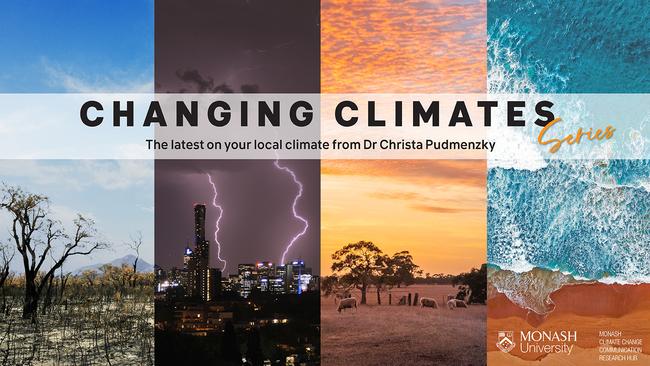The climate pendulum swinging towards extremes
Around one quarter of Aussie homes risk becoming uninsurable by the end of the decade. Dr Christa Pudmenzky explains the role of our changing climate.

Hyperlocal
Don't miss out on the headlines from Hyperlocal. Followed categories will be added to My News.
Australian communities are increasingly thrown between heatwaves, fierce fire conditions and torrential flooding rains, just like a chaotic game of catch.
Let's see how Aussies have been affected over the past few months.
Almost every state and territory has broken weather records – but not the kind we like to celebrate.
Our driest three month period since 1900 – August to October last year – was rapidly followed by a month of well above average rainfall throughout Queensland, NSW and Victoria.
Fires broke out in the Western Downs region of southeast Queensland during October and just weeks later, nearby weather stations recorded their highest November rainfall on record.
December saw northern Queensland submerged in floodwaters in the aftermath of ex-tropical cyclone Jasper, north-west NSW engulfed in bushfires, and South Australia on high alert for thunderstorms and bushfires.
The Christmas and New Year storms delivered a final blow for 2023 with $1.2 billion worth of damage across Queensland, NSW and Victoria.
These extreme events came in tandem with rising temperatures across the country, with 2023 the 8th hottest year since records began in 1910.
If we zoom in on Ipswich, we see the average nighttime temperature in March is now 1.5C warmer compared to 50 years ago.

Climate chaos
We can think about our weather like a pendulum, swinging from one set of conditions to another as we move through the seasons.
Changes in weather from day to day are completely normal, and Australia has always experienced events like fires, floods and heatwaves.
However, those pendulum swings are becoming faster and larger as many types of extreme weather increase in frequency and intensity with human-driven climate change.
This means the risk of an event that causes harm to property and lives is growing, and so is the toll on our wallets.
The cost of disasters is expected to rise to at least $73 billion a year by 2060 under a low emissions scenario where we reach net zero by the end of the century.
Around two thirds of these costs are predicted to occur in NSW and Queensland as damaging floods become more common.

Aussies uncovered
For over 180 years insurance has protected Aussies from our hostile climate, acting as a safety net for the things that matter most – our homes, lives, and livelihoods.
It has helped communities get back on their feet after disasters and also played an essential role in our economy.
Insurers provide Australian businesses and households with over 43 million policies each year and pay more than $166 million in claims a day.
However, insurance is expensive, and many just can't pay the price.
In fact, the ACCC estimates 20 per cent of homes in northern Australia and 11 per cent of homes across the rest of the country are uninsured due to cost.
Underinsurance is also widespread.
Around one-third of people whose homes have been destroyed by extreme events say their insurance payout did not cover the cost of rebuilding.
This was particularly evident in the fallout from the Black Summer bushfires of 2019-20 and in the 2022 NSW and Queensland flooding.
Accurately calculating the true value of property and belongings is essential for ensuring climate change doesn't poke holes in our safety net.
An uninsurable future
Climate change is exacerbating the barriers to insurance.
And sadly, some parts of Australia will become effectively 'uninsurable' because the risk of disaster is just too high.
One in 25 Aussie properties will be uninsurable by the end of the decade, with a further nine per cent at risk of underinsurance.
If we take a closer look at Queensland, 6.5 per cent are expected to be effectively uninsurable by 2030 – that's almost 200,000.
The majority of these sit in the electorates of Maranoa, Moncrieff, Wright, Brisbane and Griffith.
But what's the main culprit?
Of the Australian properties at 'high risk', 80 per cent are classified as uninsurable due to the risk of riverine flooding.
Bushfires and flash flooding are also major players.
On average, fires now burn over 350 per cent more land land than they did between 1988 and 2001, while extreme rainfall events – often associated with flash flooding – have increased by around 10 per cent.
Weathering the storm
While we can't stop the fires and floods of today, we have some power to steer the course of the wild weather of the future.
As always, the best way to reduce the risk of disaster is to lower our fossil fuel emissions.
Doing so can be as simple as hopping on the bike, catching public transport or brightening up your rooftop with solar panels.
In the meantime, a coordinated national approach would help arm communities with the knowledge needed to face extreme weather in their local area.
Financial support to increase the resilience of our homes – for example retrofitting fire systems – can also reduce risk and insurance costs.
This could be supported by updating building standards to reflect our changing climate.
Most importantly, we can all chip in and support communities affected by extreme events as they recover.
Let's weather the storm together.
Take the quiz
Want more information on how your climate is changing? Check out the last article in this series.
Dr Christa Pudmenzky is a climate scientist at the University of Southern Queensland.
This column is part of a collaboration between Monash University and News Corp to deliver hyperlocal weather and climate information.+


